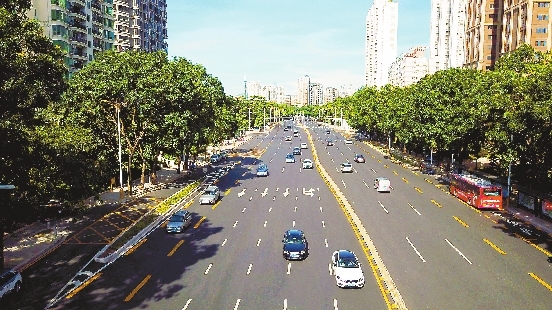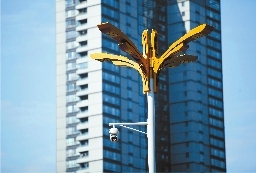

THE 6.8-km Qiaoxiang Road, which connects Futian and Nanshan districts, became the city’s first smart road recently when it was put into use after a one-year renovation. A smart road has an intelligent traffic facility that adopts new-generation technologies, like IoT (Internet of Things), big data and AI, to improve the operation of autonomous cars, and to illuminate and monitor the condition of the road. Although the traffic lights and other facilities appear no different from ordinary roads, the road uses new-generation technologies such as AI and big data to improve operation. According to a report by the Southern Metropolis Daily, the road is equipped with smart traffic lights that automatically adjust signals based on real-time information about pedestrian and vehicle flows. “AI-enabled video recognition cameras are installed at intersections and connected to the liquid crystal display (LCD) road signs and lamp posts. They can record the number of vehicles and pedestrians, and the system can automatically control the traffic lights based on the intelligent algorithm,” said Xu Teng, an engineer responsible for the project. The lamp posts have become multi-functional, with screens installed to display bus information and community maps, sensors to monitor air conditions, routers to provide free Wi-Fi and monitoring cameras. In areas that are crowded with pedestrians, such as the squares in front of office buildings, business facilities and residential compounds, the lamp posts transmit Wi-Fi signals that can be used free of charge. On the lampposts near housing estates and bus stops, LCD screens have been installed to display bus information, as well as slow-traffic guidance and community maps. The screens on the lampposts can be used as traffic signs or monitoring cameras. As a result, the number of traffic signs on the road has been reduced by one-third. At the 12 intersections along the road, cameras have been programed with additional functions making them capable of capturing violations, such as vehicles failing to give way to pedestrians, and passengers or drivers failing to fasten safety belts or follow traffic directives. The 230 manhole covers along the road have also been made smarter, with sensors installed on their undersides that send signals to the monitoring center when they are broken, jostled or removed. This road often sees traffic violations made by heavy vehicles as it is a link to trunk roads like Beihuan Boulevard and Fulong Road. A sensor system has been built on the surface of the entrance to Beihuan Boulevard, which can detect the weight and speed of vehicles and send the data back to the monitoring center. With the data, law enforcement units will be able to impose punishments on heavy trucks that break the rules by overloading, speeding, spilling or causing noise pollution. (Han Ximin) | 
